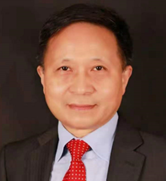Xixiang Xu
Solar Cells
LONGi Central Research Institute,LONGi Solar Technology Co., Ltd. ,Xi’an, Shaanxi, China
Email: xuxixiang@longi.com
Biography
|
Dr. Xixiang Xu is deputy director of LONGi Central Research Institute. He made his first solar cell in 1981 during his senior studies at Lanzhou University, in an amorphous silicon (a-Si) pin structure. He continued his graduate research in Prof. Chen’s group, and finally obtained 4.08% cell efficiency (related work published in 1st PVSEC, Kobe, Japan, 1984). In 1987, Xixiang started his Ph.D. study under guidance of Prof. Tatsuo Shimizu, at Kanazawa University, Japan, focusing on defects and their meta-stability in wide bandgap a-Si alloy films. In 1990, he joined Prof. Sigurd Wagner’s group at Princeton as a postdoc and studied narrow bandgap a-Si based alloys, such as a-SiGex:H films and their applications in PV. Dr. Xu started working in PV industry in 1991 at USSC, a joint venture between Energy Conversion Devices, USA, and Canon, Japan. His main effort was on developing high quality a-Si alloy films using RF, VHF, and MW excited PECVD and fabricating tandem solar cells. After a tenure at Intel to work on Si process development, Dr. Xu rejoined Uni-Solar, where he led a team to work on large-area tandem junction solar cells and achieved multiple cell efficiency world records on both double- and triple-junction cell structures. In 2010, Dr. Xu joined Apollo/Hanergy Solar as a co-CTO with Dr. Yuanmin Li. They co-founded Chengdu R&D Center in 2011, and worked on several thin film PV technologies, including a-Si:H, a-SiGe, nc-Si:H, and perovskite. In 2014, they initiated work on silicon heterojunction (SHJ) solar cell, and achieved 25.11% record efficiency in 2019. Dr. Xu joined LONGi Solar in early 2020 and led SHJ and tandem cell technology development. Though the lab construction was delayed by COVID, the team developed superior a-Si:H & nc-SiOx:H films and further optimized TCO. Within 10 months, the team had obtained 4 new world records, and increased SHJ cell efficiency from 25.11% to 26.30%, which is a highest efficiency obtained on a full size Si wafer (274.5 cm^2, total area).
|
|
|
Abstract for Presentation
Applications of Amorphous and Nano-crystalline Silicon Alloy Films in High Efficiency Si Heterojunction Solar Cell
Hydrogenated amorphous and nano-crystalline silicon films play a very important role in developing high efficiency silicon heterojunction (SHJ) solar cell technology [1-2]. Intrinsic amorphous silicon (i a-Si:H) layer provides superior passivation of defects on Si surface, obtaining very high cell open circuit voltage, while wide bandgap phosphorous doped nano-crystalline silicon oxygen alloy film (n nc-SiOx:H) serves as a more transparent window layer, enhancing the cell current [3].
In this work, three areas of SHJ solar cell process development and characteristics of the related materials are investigated, i) development of a-Si:H films with multilayer structure to provide an optimal passivation of surface defects; 2) development of n nc-SiOx:H films to yield more transparent window layer and good contact to both a-Si:H under layer and low contact resistance to overlaying transparent conductive oxide (TCO); 3) optimized metallization to ensure lower resistivity and less shadow loss for the cell. Combining the abovementioned three areas, we have achieved 26.3% total area efficiency for an SHJ cell as illustrated in Figure 1. This is the highest Si solar cell efficiency on a full size Si wafer. Electronic, optical and structural properties of both i a-Si:H and n nc-SiOx:H films will be reviewed. Perspective and technological roadmap to achieve 27% Si solar cells will also be discussed.
References
[1] D. Adachi, J. L. Hernandez and K. Yamamoto, Appl. Phys. Lett., 107(2015)233506.
[2] K. Masuko, et al. , IEEE J. of Photovoltaics, 4(2014)1433.
[3] X. Ru, M. Qu, J. Wang, T. Ruan, M. Yang, F. Peng, W. Long, K. Zheng, H. Yan and X. Xu, Sol. Energy Mater. Sol. Cells, 215(2020)110643.
WELCOME TO CHINA TO ATTEND THE ICANS
23-26 August, Nanjing, China
Connect with us:



